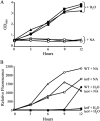Nicotinic acid modulates Legionella pneumophila gene expression and induces virulence traits
- PMID: 23319553
- PMCID: PMC3584888
- DOI: 10.1128/IAI.00999-12
Nicotinic acid modulates Legionella pneumophila gene expression and induces virulence traits
Abstract
In response to environmental fluctuations or stresses, bacteria can activate transcriptional and phenotypic programs to coordinate an adaptive response. The intracellular pathogen Legionella pneumophila converts from a noninfectious replicative form to an infectious transmissive form when the bacterium encounters alterations in either amino acid concentrations or fatty acid biosynthesis. Here, we report that L. pneumophila differentiation is also triggered by nicotinic acid, a precursor of the central metabolite NAD(+). In particular, when replicative L. pneumophila are treated with 5 mM nicotinic acid, the bacteria induce numerous transmissive-phase phenotypes, including motility, cytotoxicity toward macrophages, sodium sensitivity, and lysosome avoidance. Transcriptional profile analysis determined that nicotinic acid induces the expression of a panel of genes characteristic of transmissive-phase L. pneumophila. Moreover, an additional 213 genes specific to nicotinic acid treatment were altered. Although nearly 25% of these genes lack an assigned function, the gene most highly induced by nicotinic acid treatment encodes a putative major facilitator superfamily transporter, Lpg0273. Indeed, lpg0273 protects L. pneumophila from toxic concentrations of nicotinic acid as judged by analyzing the growth of the corresponding mutant. The broad utility of the nicotinic acid pathway to couple central metabolism and cell fate is underscored by this small metabolite's modulation of gene expression by diverse microbes, including Candida glabrata, Bordetella pertussis, Escherichia coli, and L. pneumophila.
Figures






Similar articles
-
Legionella pneumophila couples fatty acid flux to microbial differentiation and virulence.Mol Microbiol. 2009 Mar;71(5):1190-1204. doi: 10.1111/j.1365-2958.2008.06593.x. Mol Microbiol. 2009. PMID: 19170883
-
Virulence strategies for infecting phagocytes deduced from the in vivo transcriptional program of Legionella pneumophila.Cell Microbiol. 2006 Aug;8(8):1228-40. doi: 10.1111/j.1462-5822.2006.00703.x. Cell Microbiol. 2006. PMID: 16882028
-
Components of the Legionella pneumophila flagellar regulon contribute to multiple virulence traits, including lysosome avoidance and macrophage death.Infect Immun. 2005 Sep;73(9):5720-34. doi: 10.1128/IAI.73.9.5720-5734.2005. Infect Immun. 2005. PMID: 16113289 Free PMC article.
-
Legionella quorum sensing and its role in pathogen-host interactions.Curr Opin Microbiol. 2018 Feb;41:29-35. doi: 10.1016/j.mib.2017.11.010. Epub 2017 Nov 27. Curr Opin Microbiol. 2018. PMID: 29190490 Review.
-
The role of protein secretion systems in the virulence of the intracellular pathogen Legionella pneumophila.Microbiology (Reading). 2007 Dec;153(Pt 12):3948-3953. doi: 10.1099/mic.0.2007/012039-0. Microbiology (Reading). 2007. PMID: 18048909 Review.
Cited by
-
Nutrient salvaging and metabolism by the intracellular pathogen Legionella pneumophila.Front Cell Infect Microbiol. 2014 Feb 11;4:12. doi: 10.3389/fcimb.2014.00012. eCollection 2014. Front Cell Infect Microbiol. 2014. PMID: 24575391 Free PMC article. Review.
-
The LetA/S two-component system regulates transcriptomic changes that are essential for the culturability of Legionella pneumophila in water.Sci Rep. 2018 Apr 30;8(1):6764. doi: 10.1038/s41598-018-24263-9. Sci Rep. 2018. PMID: 29712912 Free PMC article.
-
New Global Insights on the Regulation of the Biphasic Life Cycle and Virulence Via ClpP-Dependent Proteolysis in Legionella pneumophila.Mol Cell Proteomics. 2022 May;21(5):100233. doi: 10.1016/j.mcpro.2022.100233. Epub 2022 Apr 12. Mol Cell Proteomics. 2022. PMID: 35427813 Free PMC article.
-
An NAD+-dependent novel transcription factor controls stage conversion in Entamoeba.Elife. 2018 Oct 30;7:e37912. doi: 10.7554/eLife.37912. Elife. 2018. PMID: 30375973 Free PMC article.
-
Meat Intake and the Dose of Vitamin B3 - Nicotinamide: Cause of the Causes of Disease Transitions, Health Divides, and Health Futures?Int J Tryptophan Res. 2017 May 3;10:1178646917704662. doi: 10.1177/1178646917704662. eCollection 2017. Int J Tryptophan Res. 2017. PMID: 28579801 Free PMC article. Review.
References
-
- Carratala J, Garcia-Vidal C. 2010. An update on Legionella. Curr. Opin. Infect. Dis. 23: 152–157 - PubMed
-
- Declerck P. 2010. Biofilms: the environmental playground of Legionella pneumophila. Environ. Microbiol. 12: 557–566 - PubMed
-
- Molofsky AB, Swanson MS. 2004. Differentiate to thrive: lessons from the Legionella pneumophila life cycle. Mol. Microbiol. 53: 29–40 - PubMed
-
- Fettes PS, Forsbach-Birk V, Lynch D, Marre R. 2001. Overexpresssion of a Legionella pneumophila homologue of the E. coli regulator csrA affects cell size, flagellation and pigmentation. Int. J. Med. Microbiol. 291: 353–360 - PubMed
-
- Molofsky AB, Swanson MS. 2003. Legionella pneumophila CsrA is a pivotal repressor of transmission traits and activator of replication. Mol. Microbiol. 50: 445–461 - PubMed
Publication types
MeSH terms
Substances
Grants and funding
LinkOut - more resources
Full Text Sources
Other Literature Sources
Molecular Biology Databases

